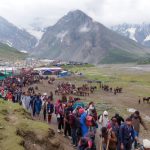Srinagar, Sep 19: The persistent dry weather in the Kashmir Valley has led to a significant drop in the water level of the Jhelum River, marking a 70-year low for the month of September. The valley has been grappling with dry conditions for over a month, posing challenges related to water scarcity and irrigation for local farmers.
While some parts of the northern valley received rainfall last week, central and southern areas continue to experience dry weather. Official records indicate that the water level at Ram Munshi Bagh has plummeted to just 2.15 feet. This is reported as the lowest water level recorded at these points in recent history, with the only comparable instances being in September 2019 and 2021 when the water level reached a mere 0 feet.
According to officials, the valley has not received adequate rainfall for the past two months, causing the Jhelum River to nearly dry up at several locations. A Field Officer from the Fisheries Department commented, “In July, we experienced significant rainfall, and a flood alert was issued at that time. However, the last three months have been exceedingly dry, and the Jhelum River, our primary water source, has been significantly affected.”
Mukhtar Ahmad, Deputy Director of the MET (Meteorological Department), said, “This September has been one of the driest on record. We have witnessed the second-highest temperatures this year since 1934 during this month, primarily due to the prolonged dry weather. September has never been this dry before, and it has taken a toll on the Jhelum River.”
Residents living along the riverbanks and houseboats shared their observations, noting that they are witnessing such low water levels for the first time. Javid Ahmad, a resident of Rajbagh, explained, “During autumn and winter, it’s common for the water level in the Jhelum to drop, but this is probably the lowest we have ever seen it. Currently, the river’s surface is clearly visible.”
The situation has raised concerns about the availability of water for daily needs and agricultural activities. Local authorities are closely monitoring the case, but the need for timely and sufficient rainfall remains crucial to alleviate the water crisis in the Kashmir Valley.








